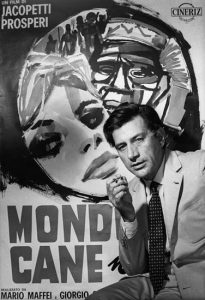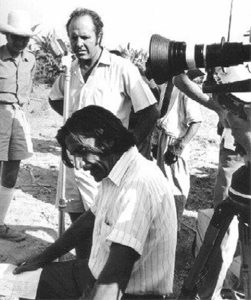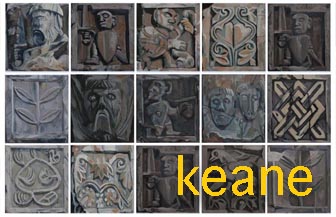 When the Italian film director Gualtiero Jacopetti, who has died at the age of 91, made Mondo Cane (A Dog’s Life) in 1962, he tapped into people’s curiosity and provided the strangest commercially successful film in the history of cinema. Audiences not yet accustomed to cheap air travel or the idea of globalisation were unprepared for technicolour National Geographic-style montages of “primitive” rites and “civilised” wrongs. The following year, they flocked to see the film’s sequels, Mondo Pazzo (Mad World, or Mondo Cane No 2) and La Donna nel Mondo (Women of the World).
When the Italian film director Gualtiero Jacopetti, who has died at the age of 91, made Mondo Cane (A Dog’s Life) in 1962, he tapped into people’s curiosity and provided the strangest commercially successful film in the history of cinema. Audiences not yet accustomed to cheap air travel or the idea of globalisation were unprepared for technicolour National Geographic-style montages of “primitive” rites and “civilised” wrongs. The following year, they flocked to see the film’s sequels, Mondo Pazzo (Mad World, or Mondo Cane No 2) and La Donna nel Mondo (Women of the World).
Mondo Cane was a film made out of a compilation of pithy sequences depicting strange rituals from around the globe. But while Jacopetti documented the peculiarities of what was then regarded as the third world, he also mocked the alleged superiority of western culture. The stupidity of mass consumerism and the absurd delusions of elite culture suddenly seemed as bizarre as cargo cults and cannibalism. The ambiguity of any political message shocked critics but delighted the novelist JG Ballard, who included Jacopetti in his 1970 novel The Atrocity Exhibition.
The power of Mondo Cane came from a side-stepping of documentary neo-realist principles in favour of a hyper-realism dubbed “shockumentary” because of its brutal edits (“shock cuts” Jacopetti once remarked), rapid zooms, heightened post-production sound effects and sharp contrasts between mis-en-scene and musical score – the much-recorded ballad More (“More than the greatest love the world has known”, in Norman Newell’s English lyrics) comes from the film. Jacopetti’s narrations were resolutely satirical, amusing, sad and at all times contemptuously despairing of humanity’s failings.
Following these box office successes, Jacopetti and the anthropologist Franco Prosperi were able to embark upon Africa Addio (Farewell Africa, 1966), a brutal, sprawling document of the post-colonial continent. The team set out to record the decimation of African wildlife as unregulated poaching took a grip, but switched to capturing violent decolonisations in Angola, Kenya, Tanzania and Rwanda as revolution and counter-revolution exploded in their faces.
The film was heavily criticised at the time of release for its alleged racist portrayal of black African people as “savages”. Jacopetti was accused of “interfering” in the anti-colonial, nationalist uprisings and orchestrating executions to fit shooting schedules. These charges were later thrown out of an Italian court.
Although it was the European colonisers who were treated most harshly in the film – notably, in a memorably creepy sequence, white South Africans – the bad publicity hit the box office, and the film sank. A reprieve came, much to Jacopetti’s horror, only in the form of a ghastly truncated US video version retitled Africa Blood and Guts.
Jacopetti was born in Barga, Tuscany. During the second world war he was involved in counterespionage with the American forces, and as normal political activity resumed ahead of the 1948 election, he worked as a publicist for the Christian Democrats.
However, it was through challenging the conformism of postwar Catholic Italy that he made his name as a journalist in the pages of the liberal weekly news magazine Cronache, which he helped found in 1953. It proved to be the forerunner of L’Espresso, launched two years later. After working on newsreels, which Jacopetti tried to make more colourful than the dry state-sponsored efforts, Jacopetti teamed up with Prosperi, cameraman Antonio Climati and composer Riz Ortolani, a unit which remained constant for all of his feature film output.
In 1971, Jacopetti both satirised American racism in Addio Zio Tom (Goodbye Uncle Tom) and took a brief diversion to script Fangio, the story of the great Argentinian racing driver Juan Manuel Fangio, for Hugh Hudson. Mondo Candido (1975) was another satirical piece, but this time a tribute to Jacopetti’s hero Voltaire, whose most famous work, Candide, seemed to echo Jacopetti’s own strange traverse through life. Again, cinematic parallels were drawn between seemingly disparate continents across random time-scales.
Tired of the increasing commercialisation of film industries and the incessant self-publicising necessary to succeed, Jacopetti returned to journalism before retiring to leave his powerful and bizarre creations in the hands of exploitation merchants, gorehounds, censorship bodies – and the term “mondo film” to the lexicon of cinema lore. He was a high-profile figure during Italy’s economic miracle of the postwar period. His charm and good looks led to a number of scandalous incidents that could have been lifted straight out of Fellini’s La Dolce Vita.
Jacopetti will be buried in Rome next to the glamorous British actress Belinda Lee, with whom he had a relationship. She was killed in car crash during the making of La Donna nel Mondo. He is survived by his daughter, Christine.
• Gualtiero Jacopetti, film-maker and journalist, born 4 September 1919; died 17 August 2011 -- source
 E’ morto ieri a Roma a quasi 92 anni (li avrebbe compiuti il prossimo 4 settembre) Gualtiero Jacopetti, regista cinematografico, originario del paese di Mologno, balzato agli onori della cronaca e della storia del cinema italiano per il film-documentario «Mondo Cane», uscito nel 1961.
E’ morto ieri a Roma a quasi 92 anni (li avrebbe compiuti il prossimo 4 settembre) Gualtiero Jacopetti, regista cinematografico, originario del paese di Mologno, balzato agli onori della cronaca e della storia del cinema italiano per il film-documentario «Mondo Cane», uscito nel 1961.
L’ultima volta che a Barga abbiamo sentito il suo nome è stato nel 2001 quando l’allora sindaco Umberto Sereni volle consegnarli il “San Cristoforo d’oro” il premio ai barghigiani meritevoli.
La notorietà a livello internazionale per Jacopetti arrivò appunto con “Mondo Cane”. Fu una pellicola che segnò un passaggio importante: riportava con crudezza bizzarrie ed atrocità di tutti gli angoli del mondo. Il tutto presentato senza mediazioni, senza filtri e con una tecnica di ripresa che per i tempi era davvero particolarmente moderna.
La prima del film, se la memoria non mi inganna, avvenne, in omaggio alle sue origini, proprio al cinema Roma di Barga.
Il film fece scalpore, suscitò indignate recensioni, ma ottenne un successo immediato. Altri film sul genere uscirono successivamente e l’ultima sua pellicola risale al 1974. Fatto sta che con Jacopetti si conobbe un nuovo modo di fare cinema e tanti produttori e registi intrapresero quella strada.
Insomma, Jacopetti è stato senza dubbio un barghigiano illustre e non sarebbe male se ai suoi finerali, tempi permettendo, fosse presente anche una rappresentanza della nostra Amministrazione Comunale.
A Mologno risiede ancora il cugino con la sua famiglia ai quali la nostra redazione porge le sue condoglianze più sentite.
Gualtiero Jacopetti (Barga, 4 settembre 1919 – Roma, 17 agosto 2011) è stato un giornalista, regista e documentarista italiano. È noto come il creatore, insieme a Paolo Cavara e a Franco Prosperi, del genere cinematografico dei Mondo movie.
Dapprima giornalista, negli anni Cinquanta interpretò il ruolo di un avvocato in Un giorno in pretura di Steno. Negli stessi anni si fece notare come sceneggiatore di Europa di notte (1959) di Alessandro Blasetti, considerato l’antesignano dei film Mondo (anche se maggiormente sul versante sexy), e nel 1960-61 realizzò assieme a Franco Prosperi e Paolo Cavara il documentario Mondo cane, rassegna internazionale di usanze bizzarre, esotiche e crudeli, un vero e proprio pugno nello stomaco per lo spettatore dell’epoca, poco abituato a certi argomenti tabù.
Nonostante le aspre critiche per la durezza delle immagini e il cinismo del commento, il film ottenne un successo enorme in tutto il mondo ed una nomination all’Oscar per la migliore colonna sonora, la celeberrima More, il tema principale dell’ispirata soundtrack del film, realizzata da Riz Ortolani e Nino Oliviero. A Mondo Cane seguì Mondo cane 2 (1963), sequel meno violento e più ironico del precedente ma altrettanto apprezzato dal pubblico, in cui molti contributi provenivano anche da Abruzzo, Calabria e Lazio (suggestive le immagini che riportano la processione e i particolari usi della confraternita dei Sacconi rossi, nella cripta della Chiesa di San Bartolomeo all’Isola, sull’isola Tiberina).
Jacopetti lavorò sempre in coppia con l’amico Franco Prosperi e con una troupe dove figurava come organizzatore lo scrittore Stanislao Nievo, pronipote di Ippolito Nievo. Per la verità Jacopetti ha sempre rinnegato il secondo capitolo di Mondo Cane poiché ritenuto una mera operazione commerciale. Molti dei contributi che si vedono nel film sono infatti scarti di montaggio del primo capitolo. Dopo La donna nel mondo, analisi meno feroce, ma parecchio irriverente della condizione della donna in vari paesi (1963) Jacopetti realizzò insieme a Prosperi Africa addio (1965-66), scioccante resoconto sui tragici effetti della decolonizzazione in Africa, con drammatiche immagini sul selvaggio sfruttamento della fauna africana e sull’inadeguatezza delle popolazioni indigene ad autogovernarsi.
Anche questo film venne duramente stigmatizzato dalla critica, che accusò il film di razzismo e gli autori di comportamenti sconsiderati (il settimanale L’Espresso sostenne che i registi avrebbero fatto ritardare un’esecuzione capitale per permetterne la ripresa, anche se anni dopo questo fatto è stato categoricamente smentito). Nel 1971 i due registi realizzarono Addio zio Tom, beffarda indagine sulla schiavitù negli Stati Uniti dell’Ottocento. Il film si discosta dai precedenti reportages perché palesa sin dalla prima inquadratura che si tratta di una ricostruzione filmata: due giornalisti scendono da un elicottero proveniente dal futuro per un reportage “in soggettiva” sul commercio degli schiavi. Anche lo stile si fa ancora più beffardo e bizzarro, allontanandosi dall’approccio asciutto dei precedenti mondo-movies della coppia.
Nel 1975 Jacopetti diresse Mondo candido, trasposizione in chiave moderna del Candido di Voltaire. Questo lavoro, che univa visionarietà e ironia, non venne compreso né dalla critica né dal pubblico ed ebbe grossi problemi produttivi, rimanendo il “canto del cigno” di questo scomodo, ma abilissimo narratore italiano. Sguardo profondo e attento del contraddittorio rapporto tra tradizione e globalizzazione sfrenata, nel corso della sua carriera Jacopetti è stato accusato a più riprese di razzismo e di un fanatismo di stampo fascista. Alle dure accuse il regista ha sempre ribadito di essere un liberale, concepito come lo intendeva il suo maestro di giornalismo Indro Montanelli.
Jacopetti lavorò inoltre con la televisione giapponese nella realizzazione di alcuni documentari. Viveva a Roma e la sua vena di viaggiatore lo portava ancora a intraprendere spedizioni e viaggi. Il 28 gennaio 2011, Bussi ha intervistato Jacopetti nel corso del programma Punto e a capo su Class News Msnbc . Sempre a Bussi, Jacopetti ha concesso la sua ultima intervista il 1° aprile 2011 nella sua casa di Roma.
Gli U2 nel corso del loro tour mondiale Zoo Tv del 1992-1993 hanno proiettato sui megaschermi spezzoni tratti dai film di Jacopetti. Esemplare il clip della versione live di Numb. E nel 2010 il cantante americano Mike Patton ha pubblicato un album di cover italiane anni 60 intitolato Mondo Cane
Nel dicembre 2010 è uscito Mondo Cane Addio. Un delirio su Gualtiero Jacopetti di Marcello Bussi, un testo in cui si intersecano una parte fiction, ove si dimostra l’impossibilità di girare Mondo Cane al giorno d’oggi, e una parte in cui si illustrano vita, pensieri e opere di Gualtiero Jacopetti. Il libro è stato autopubblicato su lulu.com.





Finalmente qualcuno che si ricorda del Regista BARGHIGIANO che ha rivoluzionato il linguaggio dei documentari nel mondo.
è da diversi anni che proponiamo di organizzare un festival del documentario intitolato a Gualtiero Iacopetti a Barga.
è triste, soltamto dopo la morte.
I was 15 in 1962, when Barghigiano Gualtiero Iacopetti’s “Mondo Cane” appeared on the screen of the Harper Theater in Detroit, Michigan. It played for a week, and I returned to see it 5 times. Everything about it bowled me over: the wild imagery and stories, the music that seemed at once to have nothing and everything to to with the film’s scenes, the sheer bizarre mentality. It made me want to see the places Iacopetti filmed, and years later I did manage to see quite a few of them. It also made me want to live in Italy, the source of his brilliant madness, and I managed that too — not realizing until recently that I had wound up in his birthplace.
Gaultiero Jacopetti dies at 91
Filmmaker made cult classic ‘Mondo Cane’
By Variety Staff
Filmmaker Gaultiero Jacopetti — the man behind documentary “Mondo Cane” and its sequels, cult classics that collected examples of the creepy and bizarre from around the world — died Wednesday in Rome. He was 91.
“Mondo cane” (the title means “A Dog’s World”) premiered at the 1962 Cannes Film Festival, where it drew accolades and was nominated for the Palme d’Or. Jacopetti called the film, which he made with his collaborators Franco Prosperi and Paolo Cavara, a “shockumentary.” Such exploitation documentaries (e.g., the “Faces of Death” series) are also now known as mondo films.
Jacopetti used both the narration and the juxtaposition of the often-disturbing material — what he called “shock cuts” — to achieve an ironic effect. In one scene, for example, a mother in New Guinea, bereaved over the death of her child, was shown nursing a piglet. The next scene depicted the slaughter of pigs in the same region for a carnal feast.
The “Mondo Cane” theme song, “More,” by Riz Ortolani and Nino Oliviero, was nominated for an Oscar.
The film divided critics in the U.S. but was a big hit worldwide, paving the way for sequels including “Mondo Cane 2.” He also made “Women of the World,” which was accused of exploiting women, and “Africa Addio,” for which he was accused of collusion with killers to obtain the violent footage in the film.
An enormous number of imitators followed in Jacopetti’s footsteps, many of the them using the word “Mondo” in the titles of their pics. Russ Meyer made “Mondo Topless,” and John Water came out with “Mondo Trasho.” There was also “Mondo Bizarro” and “Mondo Weirdo.” Some of the films with “Mondo” in the title were not even documentaries and were simply taking advantage of the popularity of Jacopetti’s work. Like some of his imitators, Jacopetti was accused by some of staging the bizarre events depicted in his films.
In 1971 he turned his attention to antebellum South — he and Prosperi made “Goodbye, Uncle Tom,” about slavery in the U.S. The framing device: Jacopetti and Prosperi appeared onscreen as filmmakers who travel back in time.
Jacopetti was born in Barga, Italy. He was a magazine editor and a maker of newsreels before he turned to feature films.
His last film, which he wrote but did not direct, was “Fangio — Una vita a 300 all’ora,” a documentary about the Formula One racecar driver Juan Manuel Fangio helmed by Hugh Hudson.